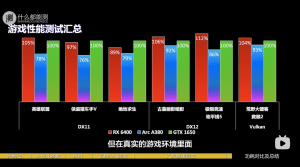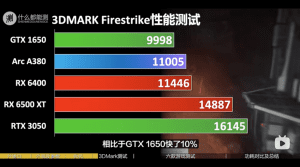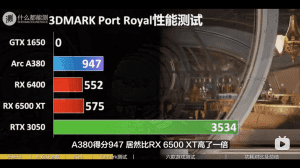
Intel introduced itself to the Arc A380 with two rendering chips in eight Xe cores and thus eight ray tracing units, 1024 shaders and 128 matrix extension engines (XMX) as well as several Xe vectored engines. Radeon RX 6400 with 4 GB of graphics memory was the chosen opponent. With 6GB GDDR6, the Intel model should really score for itself.
Chinese lab Shenmedounengce compared the Arc A380, GeForce RTX 3050, and GeForce GTX 1650 as well as the Radeon RX 6500XT and Radeon TX 6400. The test system is based on a Core i5-12400 motherboard with a B660 chipset including DDR4 memory. In addition to the 3DMark benchmark, games such as League of Legends, PUBG, GTA5, Shadow of the Tomb Raider, Forza Horizon 5 and Red Dead Redemption II were also tested. 1080p was the target resolution and also corresponds to the use range of entry level solutions.
However, the results are realistic – at least that’s how we judge them. In 3DMark Time Spy, the Arc A380 outperforms the Radeon competition and also the GeForce GTX 1650, but must admit defeat against the GeForce RTX 3050. The Port Royal Ray ray tracing test shows better performance than Radeon models, but the GeForce RTX 3050 scored more than three times.
In games it doesn’t look good anymore. The Arc A380 is overtaken by the GeForce GTX 1650 and Radeon RX 6400. The gaps are between 25% and a few percentage points compared to the GeForce GTX 1650. The gap in the Radeon RX 6400 is sometimes larger.
So far, Intel has only officially introduced the Arc A380 in the desktop area. Mobile GPUs include A3, A5, and A7 series models. The Arc A380 is based on the ACM G11 GPU with a maximum of eight Xe cores. However, desktop solutions will also use an ACM G10 GPU with up to 32 Xe cores. An overview of the expansion phases and Arc Mobile solutions can be found in Presentation Reporting.
According to the first results (further tests show similar results) of the Arc A380, the marks of other models should be evaluated somewhat conservatively. Intel will be able to keep up with entry- and mid-range, but no more. A GeForce RTX 3070, Radeon RX 6800, and possibly unattainable faster Intel in the first generation of the Arc. But of course the corresponding tests for the A5 and A7 series are still pending. You should also keep in mind that NVIDIA and AMD are already coming up with the next generation in the fall or second half of the year. The jump in performance for a second generation Arc hardware would have to be significant to really hit the mark.
Update: more results
In the meantime, there are a few field reports including benchmarks from China. This picture shows almost the same, although there may also be some volatility depending on the standard, which means that the Arc A380 looks a little better.
YouTube Privacy Notice
At this point, we would like to show you a YouTube video. However, protecting your data is important to us: by including and running YouTube, YouTube sets cookies on your computer by which you may be tracked. If you want to allow it, just click the play button. Then the video is downloaded and then played.
Your Hardwareluxx Team
View Youtube videos directly from now on

“Social media evangelist. Baconaholic. Devoted reader. Twitter scholar. Avid coffee trailblazer.”








More Stories
Google Pixel 8a in Austria with a completely different launch deal than in Germany, and you can also exchange the reward at Amazon
CD Projekt will put the tool used to create The Witcher 3 into fans' hands on May 21
Firefox 127 grants host permissions when installing MV3 extensions